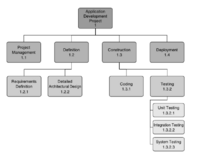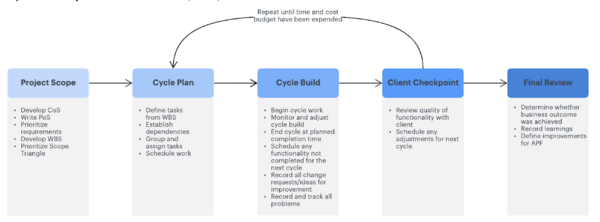Adaptive Project Framework
| Line 9: | Line 9: | ||
To implement the APF methodology successfully, project teams must be willing to accept and adapt to changes. It is a costumer driven process, where the client is involved in every stage of the process and even given the opportunity to control the direction of the project. Consequently requires the project team to be effectively involved, acting with an open mind and trusting partnership.<ref name="Howto"/> | To implement the APF methodology successfully, project teams must be willing to accept and adapt to changes. It is a costumer driven process, where the client is involved in every stage of the process and even given the opportunity to control the direction of the project. Consequently requires the project team to be effectively involved, acting with an open mind and trusting partnership.<ref name="Howto"/> | ||
| − | The APF project team is combined of client team and development team. Depending of the size of the project the client team can be a single person or multiple. In the client team there needs to be a single member in charge of the decision making, serving as a co-manager along with the development team leader. The development team is composed of technical professionals who are responsible for developing the project and producing the deliverables. | + | The APF project team is combined of client team and development team. Depending of the size of the project the client team can be a single person or multiple. In the client team there needs to be a single member in charge of the decision making, serving as a co-manager along with the development team leader. The development team is composed of technical professionals who are responsible for developing the project and producing the deliverables.<ref name="APF"/> |
| Line 58: | Line 58: | ||
<ref name="sciento"> j. Szreder, P. Walentynowicz and P. Sycz (2019) Adaptive project framework as a development project management method on the example of the Kashubska Ostoja project. Available at: http://j.mecs-press.net/ijmecs/ijmecs-v9-n1/IJMECS-V9-N1-6.pdf .</ref> | <ref name="sciento"> j. Szreder, P. Walentynowicz and P. Sycz (2019) Adaptive project framework as a development project management method on the example of the Kashubska Ostoja project. Available at: http://j.mecs-press.net/ijmecs/ijmecs-v9-n1/IJMECS-V9-N1-6.pdf .</ref> | ||
| + | |||
| + | <ref name="APF">Robert K. Wysocki Ph.D. (2010) Adaptive Project Framework. Managing Complexity in the Face of Uncertainty. Available at: https://books.google.dk/books?hl=en&lr=&id=M6GDUXXOtxsC&oi=fnd&pg=PT15&dq=adaptive+project+framework&ots=yEHeTTRqmv&sig=Jl-nX12tB_o8DMn-vYijB6R9uio&redir_esc=y#v=onepage&q=adaptive%20project%20framework&f=false .</ref> | ||
</references> | </references> | ||
Revision as of 14:05, 20 February 2021
Draft
Adaptive Project Framework (APF) is used in project management and is part of the group of agile methodologies. In so-called traditional project management, managers often approach investment projects as if surroundings and conditions behave in a stable way. However in modern society the volatility and the uncertainty need also to be taken into consideration in its business sector. Therefor traditional project management often does not work in new, difficult economy conditions, especially in software development. At the beginning of 21-century agile project management became widespread in science and practice. However solving the dilemmas of developing project with both agile and traditional project management became difficult and adaptive approach was invented to take advantage of and eliminating the disadvantages of both approaches mentioned above. Therefore the goal of this article is to present the advantages and disadvantages of the adaptive project framework approach. [1]
Contents |
Overview
Recognised strategic leader in the field of project management, Robert K. Wysocki published the book Adaptive Project Framework in 2010, where he describes the APF approach when managing complexity in uncertainty. The AFP method was created to help teams adapt continuously to projects changing environment. This is a systematic and structured process that allows project managers to enhance their decisions and practices during the project life cycle based on learning from previous results achieved during the project. PF is designed to continually adapt to the changing situation of a project from its very beginning to its very end. Therefore, with this approach, nothing is fixed: neither the duration of the project, nor the budget, nor the risks, and everything can be continuously adjusted according to changes in the project's characteristics.[2]
To implement the APF methodology successfully, project teams must be willing to accept and adapt to changes. It is a costumer driven process, where the client is involved in every stage of the process and even given the opportunity to control the direction of the project. Consequently requires the project team to be effectively involved, acting with an open mind and trusting partnership.[3]
The APF project team is combined of client team and development team. Depending of the size of the project the client team can be a single person or multiple. In the client team there needs to be a single member in charge of the decision making, serving as a co-manager along with the development team leader. The development team is composed of technical professionals who are responsible for developing the project and producing the deliverables.[4]
Application
Taking a closer look at the project framework, it consists of five main steps.
Project Scope
The first part of the process is identifying the project scope and that involves understanding the needs of the costumer. Therefore Stakeholders first step is to determine the Conditions of Satisfaction (CoS). That is the project goals and the desired outcome, by finding out what are the client's needs and how to meet those needs. From this point the Project Overview Statement (POS) is written to outline the CoS and is approved by all stakeholders, this is done to evaluate the effectiveness of the process and how it will be accomplished.[3]
Finally three documents are needed to finish the project scope. First, there is the Functional Requirements, that prioritises actions as well as possible risks, challenges and assumptions. As the project progresses, this may change. Second, there is the Work Breakdown Structure (WBS) that enables teams to estimate costs, develop schedule and break down the processes into manageable parts that need to be accomplished. Finally there is the triangle scope, which is how time, cost and quality will converge.[5]
Cycle plan
The project is divided into multiple mini-projects or cycles, where each cycle delivers one or more deliverables. This is the iterative part of the method, that is repeated over and over again for the next three steps. The cycle plan involves defining each task that needs to be accomplished in each project cycle according to the WBS but is adapted between cycles. Order of the tasks is established, their interdependencies are identified and assigned to employees with an given deadline.[2]
Cycle completion
Cycles can be changed as the team works on the project. The cycle finishes when the pre-defined time elapses, and all the tasks that were not done during this cycle transfer to the next. Ensuring consistent contact, noting any demands for change and new ideas for improvement is critical. They should also be discussed in the next cycle when the team encounters some problematic situations.[3]
Client checkpoint
The Client review is an important step of the process, this is were the client will review the accomplished deliverables during this cycle and evaluate the quality. Together with the project manager a plan will be conducted on any corrections or improvements to be made for the next cycle. Once the review is done then steps 2, 3 and 4 are iterated until the project is complete or until the time and budget has been exhausted.[5]
Post-version review
Completion of the project, the project manager, client and the team will come to together and evaluate the success of the project and determine whether project goals have been accomplished and that the client is pleased. Document of the whole process is done to reflect the effectiveness of the method, lesson learned and possible improvements for future projects.[2]
Limitations & Challenges
Agile methodologies complete projects using small releases to produce non-reusable components and these methodologies also focus on small teams because of the characteristics of face-to-face informal communication and cooperation. When a team is large, face-to-face communication becomes notably difficult, and more documentation is required, which is a deviation from the agile spirit. Meanwhile, agile methodologies characterize teams to be self-organizing according to the changing environment, which is mainly feasible for small teams and it does not work for larger teams, where more time is required to self-organize according to a change. The support for large and complex software projects is also limited in agile development assuming that refactoring will purify the code. the agile spirit holds true for small projects but becomes notably difficult in large and complex projects. agile methodologies cannot handle large projects because of the difficulty in tracking the system development life cycle (SDLC) phases of the project.
Conclusion
Adaptive Project Framework is a very effective method that enables teams to forget about the limitations of traditional project management approaches. Similarly to the traditional models, APF also includes scoping and planning phases. However, an adaptive framework allows for effective collaboration between teams and stakeholders. This way, they can adapt the project to the changing environment and quickly react to unforeseen challenges. APF is a flexible approach. When used correctly, it can also help companies minimise expenses and maximise the value proposition. Nevertheless, you should keep in mind that every project is unique, and APF cannot be called a universal approach that will fit projects of all kinds. With that said, if you’re looking for flexibility, APF is certainly the right choice.
Annotated Bibliography
http://j.mecs-press.net/ijmecs/ijmecs-v9-n1/IJMECS-V9-N1-6.pdf
References
- ↑ j. Szreder, P. Walentynowicz and P. Sycz (2019) Adaptive project framework as a development project management method on the example of the Kashubska Ostoja project. Available at: http://j.mecs-press.net/ijmecs/ijmecs-v9-n1/IJMECS-V9-N1-6.pdf .
- ↑ 2.0 2.1 2.2 David Galiana (2020) Adaptive Project Framework: an introductory guide for beginners. Available at: https://www.wimi-teamwork.com/blog/adaptive-project-framework-introductory-guide-beginners/ .
- ↑ 3.0 3.1 3.2 Frank Hamilton (2021) Adaptive Project Framework: How to Implement It. Available at: https://www.startupvalley.news/adaptive-project-framework/ .
- ↑ Robert K. Wysocki Ph.D. (2010) Adaptive Project Framework. Managing Complexity in the Face of Uncertainty. Available at: https://books.google.dk/books?hl=en&lr=&id=M6GDUXXOtxsC&oi=fnd&pg=PT15&dq=adaptive+project+framework&ots=yEHeTTRqmv&sig=Jl-nX12tB_o8DMn-vYijB6R9uio&redir_esc=y#v=onepage&q=adaptive%20project%20framework&f=false .
- ↑ 5.0 5.1 ThinkTheme (n.d.) Adaptive Project Framework Methodology. Available at: https://thinkthyme.com/project-management/adaptive-project-framework-methodology .

